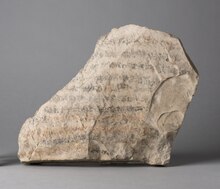
Back تعاليم دوا-خيتي Arabic Sàtira dels oficis Catalan Lehre des Cheti German Sátira de los oficios Spanish Enseignement de Khéty French ההוראה מפי דואה חתי HE Sindiran Perdagangan ID Satira dei mestieri Italian Nauki Dua-Khety Polish Sátira dos Ofícios Portuguese

The Satire of the Trades, also called The Instruction of Kheti, is a didactic work of ancient Egyptian literature.[1] It takes the form of an instruction and was composed by a scribe from Sile named Kheti for his son Pepi. The Satire exalts the career of a scribe while remarking on the drudgery experienced in other professions. Laborers are described in the document as having tired arms and to be living in subpar conditions. This poor standard of living is juxtaposed with the life of a scribe, whose job is "greater than any profession". Egyptologists disagree on whether or not the text is satirical. The same Kheti may have composed the Instructions of Amenemhat, but this is unclear.[2][3]
The entirety of the document survives on the Papyrus Sallier II at the British Museum (Museum number EA10182,11), but it is extremely corrupted. Some fragments are kept at the British Museum, the Louvre, the Morgan Library & Museum, and other institutions.[4] This instruction is referenced by Ben Sira in the Deuterocanonical Book of Sirach at Sirach 38:24–39:11.[5]
- ^ Bard, Katherine A. (1999). Encyclopedia of the Archaeology of Ancient Egypt. Routledge. p. 886. ISBN 9780415185899.
- ^ Parkinson, R.B (1998). The Tale of Sinuhe and Other Ancient Egyptian Poems 1940-1640 BC. Oxford University Press. pp. 273–83. ISBN 9780199555628.
- ^ Edwards, I.E.S; Hammond, N.G.L; Gadd, C.J (1975). The Cambridge Ancient History. Cambridge University Press. p. 257.
- ^ Lichtheim, Mariam (2006). Ancient Egyptian Literature, Volume I : The Old and Middle Kingdoms (2nd ed.). University of California Press. pp. 189–198. ISBN 9780520933057.
- ^ Rollston, Chris (2001). "Ben Sira and the Satire of the Trades 38:24-39:11 and the Egyptian Satire of the Trades: A Reconsideration". Journal of Biblical Literature. 120 (1): 131–9. doi:10.2307/3268597. JSTOR 3268597 – via JSTOR.